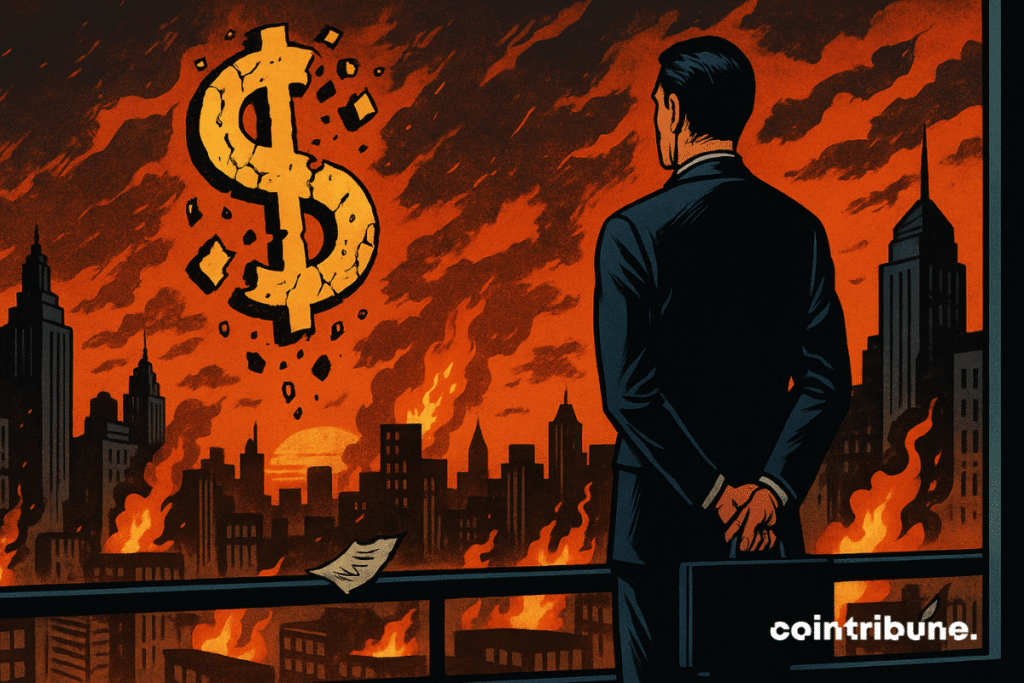Morgan Stanley Warns: USD Teetering on Edge of COVID-Level Collapse
Wall Street’s crystal ball gazers at Morgan Stanley just flashed a red alert—the greenback might be heading back to pandemic-era lows. Buckle up.
No fancy charts or jargon here: the bank’s analysts see the dollar sliding like a rookie crypto trader’s portfolio during a leverage wipeout. And yes, that’s as ugly as it sounds.
Remember March 2020’s toilet-paper-hoarding panic? Apparently, the currency markets might reenact that horror show—minus the actual Charmin shortages.
One cynical aside: If the Fed prints its way out of this too, maybe we should start pricing everything in Satoshis anyway. Just saying.

In Brief
- Morgan Stanley bank forecasts a 9 % drop in the US dollar within a year, returning it to its lowest levels since the Covid-19 pandemic.
- This forecast is based on a slowdown in the US economy and expectations of significant rate cuts by the Federal Reserve.
- Morgan Stanley observes a notable rise in competing currencies such as the euro, British pound, yen, and yuan.
- This dynamic could weaken the global dominance of the dollar and pave the way for a global monetary rebalancing.
The dollar under pressure : economic slowdown and anticipation of rate cuts
While a bill threatens the dollar and could trigger a systemic economic crisis, the strategists of Morgan Stanley bank in a note sent to investors on May 31 announced a quite significant forecast:
We believe that rate and currency markets have initiated lasting trends that will push the dollar much lower and steepen the yield curve.
According to the investment bank, the Dollar Index (DXY) could plunge to 91 points over the next twelve months, a 9 % drop, which WOULD bring the American currency down to its lowest levels observed during the pandemic.
This decline would add to an already well-established fall: the dollar has lost nearly 10 % since its peak in February 2025, fueling concerns about its resilience in the short and medium term.
This anticipated depreciation of the greenback is based on several converging macroeconomic factors, now clearly identified by analysts :
- A slowdown in American growth, which weakens global demand for the dollar ;
- A monetary policy expected to be much more flexible : Morgan Stanley forecasts -175 basis points of Fed rate cuts by 2026 ;
- Persistent tension in bond markets, with 10-year yields projected at 4% by the end of 2025, before a more marked decline;
- The deleterious effects of trade tensions revived by the Trump administration, weighing on the confidence of foreign investors ;
- A general movement of capital repositioning, as the dollar looks increasingly less attractive on foreign exchange markets.
At this stage, Morgan Stanley no longer speaks of a simple bearish cycle but rather of a monetary paradigm shift, marked by DEEP structural trends that could last well beyond the twelve months mentioned in the projection.
A structural decline of the dollar : the role of BRICS and competing currencies
Beyond macroeconomic fundamentals, the expected fall of the dollar fits into a global geopolitical dynamic, driven by the rising power of the BRICS and the acceleration of dedollarization.
Morgan Stanley thus highlights a shift in the preferences of global investors : “Currency traders are starting to consider local currencies for the first time while the dollar stagnates on the charts“.
This change of direction is illustrated notably by a 19 % drop in foreign purchases of US Treasury bonds, in favor of assets denominated in yuan, rupee, or euro.
In such an environment, several rival currencies record notable gains against the dollar. Morgan Stanley expects the euro could reach 1.25 against 1.13 currently. The Japanese yen would appreciate to 130 against 143, and the British pound would climb to 1.45 against 1.35.
These projections reflect a gradual shift in the global monetary center of gravity. The BRICS, who aim to offer an alternative to the dollar for international trade, benefit from this strategic dollar retreat.
The erosion of confidence in the American currency could, in the long term, redefine capital flows and challenge the dominance of the dollar as the world’s reserve currency.
While the WHITE House tries to downplay the scope of this dynamic, some analysts believe the current evolution marks the beginning of a systemic realignment, in which the United States could gradually lose its global monetary leverage due to the transition to numerous local currencies. If Morgan Stanley’s forecast comes true, it could serve as a catalyst for a broader transformation, where cryptos, emerging currencies, and regional currencies would compete for a new role as a reference on international markets.
Maximize your Cointribune experience with our "Read to Earn" program! For every article you read, earn points and access exclusive rewards. Sign up now and start earning benefits.

